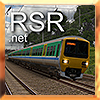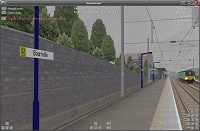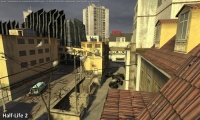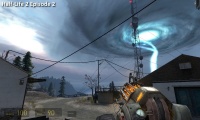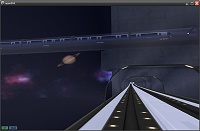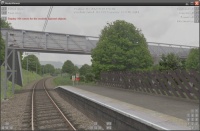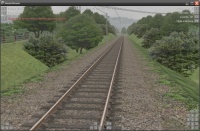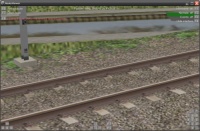- [WJ-R]: 1980s object removal (Castlethorpe/Hanslope area)
- [XCS]: Pending
- [UkTrainSys]: v0.3.2.0 released
- [Object Library]: Preparing...
- [Website]: Fifth version of website launched
 My openBVE videos and other comments from users and
myself can also be found via my YouTube
channel.
My openBVE videos and other comments from users and
myself can also be found via my YouTube
channel.Blog and Progress Updates
7th January 2009
3D lineside vegetation with wind and turbulence effects, animated butterflies, new Autumn textures and leaf fall
Posted by Anthony Bowden on 7th January 2009 at 10:00 pmI’ve been working on some more animated objects for Cross-City South v1.4 and » openBVE «; this time, I’ve tried something I’d wished I could have achieved ever since I created the grassy embankments for the Watford Junction to Rugby route, and hence even long before the openBVE project was started; namely animated lineside vegetation which sways in the wind, and responds to the turbulence created by the passage of the player’s train. One criticism pointed out to me in my routes is the use of 2D lineside trees, which becomes a problem when viewed side-on as is now possible with openBVE’s camera views. Rotating the trees appropriately is one way to reduce this problem and is ideal where performance is important, but I wanted to try using 3D trees just to see how well they worked; so I’ve now created largely 3D trees, which include trunks and branches, as well as foliage clusters, with each component animated appropriately to create quite a nice effect, hopefully bringing some of the beauty of nature to life in the route.
I was originally planning to release the new scenery as part of the Watford Junction to Rugby project, however I’ve now decided to include this in Cross-City South v1.4 instead, which will be released sooner than the aforementioned route. The Cross-City update is proving to be a far more significant upgrade than I originally planned, which does mean Watford to Rugby will be delayed again (I had said privately, that by April I might be closer to finishing it, but this is unlikely now–sorry), so I thought it might be better to have some of it’s features brought forward and included as part of the next Cross-City release instead.
The newest preview video includes photo-realistic Summer and Autumn objects, textures, and higher resolution backdrops, and features grass, foliage, flowers and bushes which sway gently in the breeze, but which as mentioned above, also appear to be disturbed by turbulence caused by the passage of the player’s train, achieved easily by using the Distance variable (which currently provides the distance from the player’s train to the animated object), along with an additional rotation function with associated damping. I’ve also created some animated butterflies (which are simply adapted from the flashing level crossing light available in Michelle’s » DemoRoute1 «, with different objects, a faster refresh rate and extra translation functions applied), which complement the new plant life and animated birds in the Summer routes. The Autumn trees also include falling leaves which gently sway back and forth in the breeze as they float to the ground, which adds a little more fun to wheelslip scenarios. ![]()
These animated vegetation objects are loaded via Ground and Dike commands so can be cycled and repeated respectively, and a reasonably fast PC will likely be needed for full enjoyment; however to keep framerates higher, the use of animated vegetation will probably be limited to maybe 300m lengths of route at locations like station areas, signals which could be held at red whilst enroute, and various points of interest (see below for more information). Waiting for departure at a station, or for a signal to clear from red, needn’t be so dull in future. ![]() In between these selected locations, static, but nevertheless 3D trees will be used, probably along with static versions of the grassy embankments although using animated versions may be possible performance wise; I’m not sure about this yet. You can’t easily appreciate the animation from the cab when travelling at speed anyway, so it’s not really a problem. Further away from the track, simple, non-animated 2D trees will be retained (but rotated and placed carefully to minimise the 2D appearance), as openBVE is primarily a cab-view simulator of course.
In between these selected locations, static, but nevertheless 3D trees will be used, probably along with static versions of the grassy embankments although using animated versions may be possible performance wise; I’m not sure about this yet. You can’t easily appreciate the animation from the cab when travelling at speed anyway, so it’s not really a problem. Further away from the track, simple, non-animated 2D trees will be retained (but rotated and placed carefully to minimise the 2D appearance), as openBVE is primarily a cab-view simulator of course.
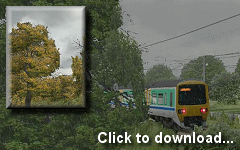
Video: Demonstration of 3D animated vegetation and turbulence on passage of player’s train, animated butterflies, new Summer and Autumn textures, and Autumn leaf fall effects. Also includes the swinging cables and flying birds » previously demonstrated «.
Note: This video is now included as part of a compilation on YouTube.
« [YouTube “High Quality” version] | [YouTube “High Definition” version]
Tags: Animated Objects, Cross-City South, openBVE, Videos
Posted in openBVE | 1 Comment »
Hardware upgrades, performance, and detail levels
Posted by Anthony Bowden on 7th January 2009 at 9:00 pmEvery time I upgrade the system on which I develop routes, I find that new options and possiblities always arise, and I can add new objects or textures to take advantage of the extra processing power, and step-up the quality of my routes accordingly. I’m planning on a major upgrade in just a few months which will let me find out just what I can get away with where Watford Junction to Rugby and openBVE are concerned, and this will likely be a Core 2 Duo E8x00, along with a recent graphics card. However, I treated myself to an interim hardware upgrade at Christmas, to help support my add-on development for openBVE during the next few months. I felt that my aging AthlonXP 2400+, 1GB DDR-266 system with GeForce 6600GT 128MB AGP graphics card, on which I’ve been developing routes, was finally beginning to hold me back too much as I explored the extent to which I could utilise animated objects in my routes.
Cross-City South v1.4 and Watford Jn to Rugby are now being developed on a dual core Athlon64 X2 4200+ system, with 2GB DDR2-800 dual channel RAM, along with a Radeon HD 2600 Pro 256MB PCIe graphics card (» see here for details «), which has enabled me to add more animated objects to the Cross-City than I’d have considered reasonable while developing it on the old system; while the extra performance makes little useful difference on more simple routes as framerates were already high, I’ve measured a 30-50% performance increase in terms of openBVE’s framerates when the new animated scenery objects I’ve just shown are used, making what was previously just about acceptable, now enjoyable. The new hardware is hardly cutting edge technology though, so hopefully enough openBVE and Cross-City South users will have hardware that’s of a similar specification, and can enjoy similar levels of performance to that which I will enjoy when Cross-City South v1.4 is released. The double track (Weedon Line) section of the Watford Jn to Rugby Maximum Detail route has never really been a problem performance wise, but in openBVE I’m also now getting up to 15-20fps on some of the more complex four track sections, where I got 8-15fps before typically, and loading times are down to 21 seconds, while they were at 49 seconds previously. The “normal” version of the route which will actually get released should be pretty trouble free by the look of things… ![]()
Where Cross-City South v1.4’s new scenery is concerned, what I plan to do is simply add as much 3D lineside vegetation as possible while maintaining around 30fps @ 1280×1024 resolution on the new system; tests I’ve conducted so far reveal that I should be able to easily include static grassy embankments and more simple static 3D trees throughout the route, along with the selected areas of high detail, animated 3D vegetation and trees as shown in the video, in locations as outlined above. I’ve also done some optimisation work on New Street for Cross-City South v1.4, and New Street framerates are now up to a very acceptable 24fps on the new system, and I’ll try my best to maintain this level of performance as the route develops.
For openBVE, I don’t think I’ll offer much by way of “Detail Levels” as I have done in the past for my BVE routes; at the moment I think there will be a high detail version which is essentially what I’ve described above, and a standard version which will include a few less animated objects and maybe some more geometrically simple objects too. I will also update the BVE 2 and 4 versions of the Cross-City South with some new textures as well, as time permits.
Tags: Hardware, openBVE, Watford Jn to Rugby
Posted in openBVE | No Comments »
23rd December 2008
Superelevation, Flashing Aspects, Animated Points, and Station Signs
Posted by Anthony Bowden on 23rd December 2008 at 10:00 pmI’ve been continuing with some more cosmetic updates for Cross-City South v1.4, and I’m in the process of adding superelevated track, transition curves and lead-in/lead-out track objects to enable smooth changes from level to canted track. With » Watford Junction to Rugby «, which already includes superelevated track objects and lead in/out objects, I’d adopted a system where curved track objects with 35mm, 70mm and 125mm cants were modelled, with a set of lead-in/out transition objects going from 0-35mm, 35-70mm and 70-125mm at varying curve radii, which enabled a nice, gradual increase or decrease in cant within a curve. These lead in/out objects are placed not as .Rail objects, but as .FreeObjects, and are used in conjunction with one of several invisible null rails which each have a different run sound, such that I don’t need to add too many new railtypes to cover all the possible combinations of run sound and required canted transition curve objects. This technique still results in quite a number of FreeObjects however.
While looking at the » ATS-Sn/P Test Route «, I was impressed by the appearance of the superelevated track and transition curves, which I felt were better than my attempts, and while looking at how the author achieved such a good result, I was pleasantly surprised to find that the technique used is actually more straightforward and efficient than that which I’d adopted, with just a simple pair of straight, left/right lead-in and lead-out objects used. I’ve trialled this on the Cross-City South, and I’m pleased with the results on the sharper curves, although for larger radius, higher speed curves, I’ll retain graduated 0-70mm and 70-125mm canted transition curve objects:
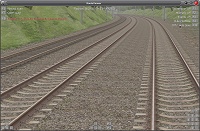
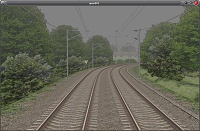
– Please note that the grass and terrain textures are only temporary
I’ve also been experimenting with the signalling functionality recently introduced into openBVE’s » animated object format «. I’ve now implemented flashing aspects which are used on the approaches to the 60 mph and 70 mph crossovers between the fast and slow lines on the WCML’s New Ledburn and Hanslope Junctions, respectively. I’ve also incorporated lens hoods which become illuminated according to the aspect displayed by these new signal objects, and these look better than the standard flat bitmaps usually used to represent signal aspects in BVE.
Jason Morgan, one of the people we can thank for introducing BVE to Western railsim users several years ago, asked me whether or not it would be possible to have animated points linked to a signal, such that the blades moved to the correct position prior to the signal clearing, for example, while the player’s train is waiting in a passing loop before being cleared to rejoin the main line. Indeed this is possible, either by making the point blade position depend upon the state of a section, or by making the animation functions conditional, for example, by basing them upon the distance from the set of points to the player’s train. When basing the point blade position upon a section state, this can be done simply with the aid of a .Pretrain command, such that the point blades move as the signal changes from red. However, by using a .Section 0;2;3;4;5 command (UK routes with 4 aspect signals usually use .Section 0;2;3;4), and a specially modified animated signal object which displays an aspect sequence of Red > Red > Yellow > Double Yellow > Green, the point blades can move prior to the signal aspect appearing to change from red, which looks more prototypical. This is only suitable when the player arrives at the signal while it’s associated section state is still 0 (red), however.
As part of the experiment, I created some fully animated point objects, which include moving point blades, stretcher bars, backdrive assemblies, linkages and levers. » openBVE’s « rotation damping functions also enable a rather nice motion of the point blades, which looks quite realistic. Both conventional and High Performance Switch System (HPSS) points are modelled.
Important note: Currently, trains in openBVE follow a single path throughout a route as with BVE Trainsim (based on Rail 0), with this one path coded in the route file which cannot be changed en-route. Therefore, these points are cosmetic only!
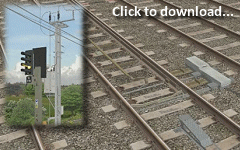 Video: Demonstration of working 3D bulb and LED signals, flashing apects, and animated pointwork
Video: Demonstration of working 3D bulb and LED signals, flashing apects, and animated pointwork
Note: this video is now included as part of a compilation on YouTube.
« [YouTube “High Quality” version] | [YouTube “High Definition” version]
Stephen Cross has also kindly created a set of station sign textures for use in Cross-City South v1.4, so I’ll be creating a new set of objects allowing the actual station names to be displayed on signs at each station on the route:
I’ll also create some new lampost objects for the stations, as the existing ones look, well lets be honest, terrible. ![]() If I have time, I’ll update the route to include London Midland textures as well, although this isn’t a priority for me at the moment.
If I have time, I’ll update the route to include London Midland textures as well, although this isn’t a priority for me at the moment.
Finally, I’d like to wish visitors to Rail Sim Routes UK a very Happy Christmas! ![]()
Tags: Animated Objects, Cross-City South, openBVE, Screenshots, Trackwork, Videos, Watford Jn to Rugby
Posted in openBVE | 16 Comments »
6th December 2008
Animated, Segmented Objects
Posted by Anthony Bowden on 6th December 2008 at 10:00 pmWhile creating the swinging cable objects demonstrated in the recent openBVE Object Animation/X-City South video (see the 1st December 2008 entry below), I opted to keep things simple and just rotate each 50m length of cable around it’s Z-axis to create the swinging effect I wanted; this was appropriate and sufficient for the types of cables in question. However, it’s also possible to split such an object up into segments, which can each be rotated and translated individually, to create more complex motion, bouncing, or to create the impression of elastic properties. When I was thinking about how best to animate the cables, it occurred to me that there was a rather nice application for the segmented object approach, in the form of people with animated limbs and simulated joints. I’ve been working on a slightly more ambitious animated object this time, namely a walking person which appears to have articulated limbs (please forgive the temporary placeholder objects comprising the figure, this is just an experiment and an early demonstration):
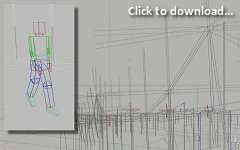
Video: openBVE v0.9.1.15 and X-City South v1.4 (work in progress)
Animated, segmented bouncing cables; plus animated person with simulated articulated limbs (temporary meshes only)
Note: This video is now included as part of a compilation on YouTube.
« [YouTube “High Quality” version] | [YouTube “High Definition” version]
Each 50m long bouncing cable is comprised of 8 segment objects, each individually rotated and translated to create the overall movement shown. The animated person as a whole is comprised of 15 separate component parts, which means the upper and lower arms, upper and lower legs, upper and lower torso, feet, neck and head can be manipulated individually to create certain animated movements. It would be possible to have the figure waving, or moving one of his/her arms to check the time on a wrist watch, for example. The tricky part now, will be creating more detailed geometry and textures for the animated people which I hope to include in Cross-City South v1.4.
Finally, if you find the above interesting, then I recommend you visit the » openBVE homepage « and download the latest version 0.9.1.15 of the program, along with the updated DemoRoute1. In another stroke of genius, Michelle has added both a working signal with a flashing aspect, and a working lower quadrant semaphore signal to the route, complete with lamp and damped semaphore arm motion. Highly impressive! As she mentions in her » Developer Log «, the .AnimatedObj command can now reference sections in a similar way to the .SigF command, and an animated object can get the state of that section, therefore the flashing aspects found on the signals approaching the New Ledburn and Hanslope Junctions on my Watford to Rugby route can now be implemented realistically. I’ll be having a play with this new functionality during the next few days.
Tags: Animated Objects, Cross-City South, openBVE, Videos
Posted in openBVE | No Comments »
1st December 2008
More Animated Objects
Posted by Anthony Bowden on 1st December 2008 at 10:00 pmWhile my favourite games are naturally openBVE and BVE Trainsim, another game which has also made a great impression on me is the first-person shooter Half-Life 2 and it’s follow-on episodes. I love this series of games because of the unfolding sci-fi story arc, mythology, characters, exotic technology, blend of elements of past, present and future, interactive environments and physics modelling; but they also feature some exceptionally high quality photo-realistic textures, lighting, atmospheric scenes, visual effects and a variety of nice touches which help to bring Half-Life 2’s dystopian world to life. Now that openBVE’s animation capabilities can be experimented with, I thought I’d bring a couple of the things I’ve noticed in Half-Life 2 to my own routes–no, not portal storms, teleportation devices or xenomorphic creatures wreaking havok in the streets of Birmingham, tempting though that is; rather animated birds and cables. Okay, maybe not quite as exciting, but anyway, Half-Life 2 features birds which fly past in places, and cables which sway in the wind:
Using openBVE’s animated object translation and rotation functions, similar effects can be created. I downloaded a Reverse Polish Notation calculator to assist me in understanding what some of the translation values being calculated actually are, and this helped me to create birds which move at the right speed at the right time, and have flapping wings to add a little life to them, although I haven’t figured out how to increase the speed of the flapping yet. The return conductor cables sway back and forth as though buffeted by strong gusts of wind, and I exchanged the sine and cosine functions in alternating objects so each cable length doesn’t sway at the same time as the next, making the overall movement look rather more natural. I’ve amended my previous video with some extra shots of these features:
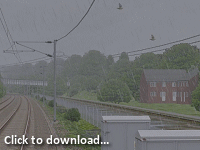 Video: openBVE v0.9.1.7 and X-City South v1.4 (textures and scenery not finished yet)
Video: openBVE v0.9.1.7 and X-City South v1.4 (textures and scenery not finished yet)
Animated clouds, flying birds, falling rain, swaying cables, moving water, and a passing train
Note: This video is now included as part of a compilation on YouTube.
« [YouTube “High Quality” version] | [YouTube “High Definition” version]
Class 150 objects from » Network West Midlands «
I hope you like the effects. ![]()
Note: Just to reiterate, openBVE will have built-in rainfall in future, so using animated objects to create this effect won’t be required eventually; but I was curious to see if such effects were possible with animated objects alone. The passing train is just a fun experiment, and animated objects aren’t really suited for this purpose as the animated object doesn’t follow any track, but rather a direction defined in the animated object file; I probably won’t include it in the final release route as there’s no sound accompanying the train.
Tags: Animated Objects, Cross-City South, openBVE, Screenshots, Videos
Posted in openBVE | 1 Comment »
26th November 2008
openBVE’s Object Animation
Posted by Anthony Bowden on 26th November 2008 at 10:00 pmIf you’ve visited the » openBVE Homepage « recently, you’ll know that Michelle has released openBVE v0.9.1.5 and DemoRoute1, and these introduce animated objects to the community for the first time. While the new animation capabilities are just a preview, aren’t supported yet and are subject to change, I’ve been playing with the new functionality to see what might be possible. As the animation capabilities may be altered in future versions of openBVE, none of these X-City demonstrations should be considered final.
In Michelle’s DemoRoute1 we can see an animated departure screen, clock, an A320 flying overhead, flashing level crossing light, moving cars and simulated interaction, and an escalator. These are the kinds of features I’d like to add to Cross-City South v1.4 as well, as they’re just brilliant–but rather than show you what Michelle has already demonstrated, I thought I’d start with something a little different. In the video below, I’ve used .PointOfInterest commands, and placed animated sheets of rain to create the effect of precipitation (achieved via texture shifting), moving clouds achieved via the same method, and animated water on the canal.
Note: openBVE will have built-in rainfall in future, so using animated objects to create this effect won’t be required eventually; but I was curious to see if such effects were possible with animated objects alone.
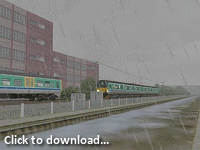 Video: openBVE v0.9.1.7 and X-City South v1.4 (textures not finished yet)
Video: openBVE v0.9.1.7 and X-City South v1.4 (textures not finished yet)
Animated clouds, falling rain, moving water, and a passing train
Note: This video is now included as part of a compliation on YouTube.
« [YouTube “High Quality” version] | [YouTube “High Definition” version]
Class 150 objects from » Network West Midlands «
A note on the passing train–this is just a fun experiment, and animated objects aren’t really suited for this purpose as the animated object doesn’t follow any track, but rather a direction defined in the animated object file; I probably won’t include it in the final release route as there’s no sound accompanying the train. However, the technique is suitable for trains passing over or under bridges for example, like in the » IIYAMA Line 2060 « route, where the train is some distance from the player, moving across the screen (Lichfield Trent Valley on the Cross-City North route could also be a suitable location for such an effect):
The moving water in the above X-City South v1.4 video also needs some work, but involves a static canal object with ordinary texture, and then two animated, texture shifted alpha-enabled surfaces overlaid; one moving left to right (to match the cloud’s direction of movement), and the other moving along the Z-axis. When combined, they make the water appear to ripple slightly if you look closely for a few seconds, particularly where the tree reflections are visible on the right.
Tags: Animated Objects, Artwork, Cross-City South, openBVE, Screenshots, Videos
Posted in openBVE | No Comments »
Cross-City South v1.4 Update
Posted by Anthony Bowden on 26th November 2008 at 9:00 pmThe Cross-City South v1.4 update has been in progress for the past few days. To start with, I’ve rearranged all the files into a less complicated directory structure, and removed the seasonal variations for the time being, with just Summer remaining for now. I’ve also removed all but two route files from the package, which I’ll work on to create a new foundation on which other route files can be created in future; this makes maintenance much easier and the updated route quicker to check for problems. I’ve also been removing all .X format objects, which I’ll replace with .CSV versions, with surface illumination achieved via openBVE’s new extended commands instead, along with day/night texture transitions achieved using single objects rather than seperate day and night objects, as was the case in Cross-City South v1.3 for BVE4. This helps to save some disk space, along with making the route much easier to maintain.
Along with openBVE’s error reports, I’ve also been using Oskari’s » BRR.NET « utility to check for other issues, to ensure that the new “template” route files are as trouble free as possible. I’ve also been updating the route with new vegetation textures and track objects, taken from the Watford Junction to Rugby route; here’s how it’s looking so far in the openBVE Route Viewer tool (the reported errors are temporary, due to missing textures which I haven’t relocated yet!):
The shadow effect used for the bullhead rails is based on an idea which Simon Gathercole came up with a while ago. The next time consuming task will be updating all the pointwork, which I’ll start work on soon. I’ll also be exchanging the terrain and grass textures for new versions, making the scenery look better when using the external views, adding backfaces to various objects so the route can be viewed in the opposite direction without needing to hit F11 in openBVE, and adding soft shadows to various objects, which together with the new textures shown above, should improve the appearance of the route considerably. Due to popular demand I’ll be creating a new diagram which starts from the Longbridge reversal siding rather than Redditch, and I’ll also be looking into more animated object possibilities; I have a few ideas already.
Tags: Cross-City South, openBVE, Screenshots, Software, Trackwork
Posted in openBVE | No Comments »
20th November 2008
Rugby Area
Posted by Anthony Bowden on 20th November 2008 at 10:00 pmI thought I’d show the current state of Rugby station, as I haven’t posted any screenshots of this location yet (due to it being unfinished). I’ve only laid the track and electrified the area so far, but as you can see from the images below, this is a very complex location to model, with numerous tracks, diverging lines, two flyovers, pointwork, curves and so-on. There’s no finished scenery yet, and the supports are missing from beneath the flyover, but once these, and the station buildings and lineside buildings are added, it should look rather good.
Please note that in the overhead shots, a 2400m drawing distance is set with a high level of zoom used, hence the station looks somewhat shorter than it actually is, and the curves sharper than they actually are. The released route will be based on the track layout prior to the recent remodelling work at the real station (I have to draw the line somewhere with a route that’s being constantly upgraded in reality; this way I might actually be able to finish the project!!). The track layout depicted here is a mixture of the layout as it was in the 80s and late 90s, and I’ll remove the relevant tracks in the final route files, depending on the era being depicted in each one:
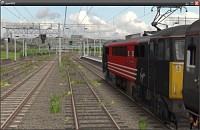 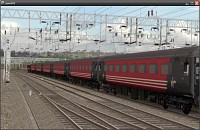 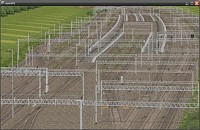 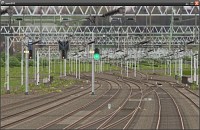 |
Tags: openBVE, Screenshots, Trackwork, Watford Jn to Rugby
Posted in openBVE | No Comments »
